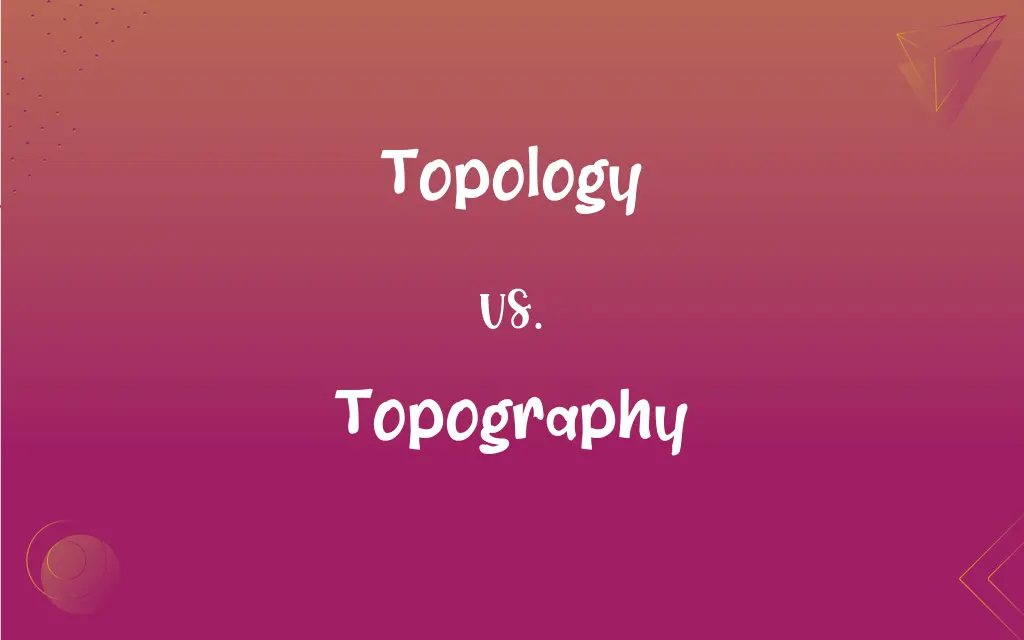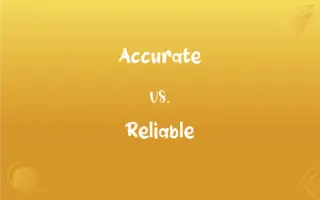Topology vs. Topography: What's the Difference?
Edited by Harlon Moss || By Janet White || Updated on October 10, 2023
Topology studies properties of space that remain unchanged under continuous deformations, while Topography maps physical features and elevations of an area.

Key Differences
Topology and Topography may sound similar, but they represent entirely different fields of study. Topology is a branch of mathematics that delves into the study of properties of space that remain constant under continuous deformations, such as stretching or twisting. Topography, in contrast, is concerned with mapping the physical features and contour lines of an area, particularly the Earth's surface.
Topology explores concepts like continuity, compactness, and boundary. It is more abstract and not confined to the physical world. Topography, on the other hand, focuses on the tangible and visible aspects of terrains, such as hills, valleys, rivers, and roads.
In the realm of network design and computer systems, Topology refers to the arrangement or configuration of a network, including its nodes and connecting lines. Meanwhile, Topography remains grounded in geography and Earth sciences, where it's essential for cartography and landscape analysis.
Another interesting distinction is the applications of both fields. Topology has vital applications in various branches of science, including physics and computer science. Topography plays a crucial role in fields like civil engineering, urban planning, and environmental science.
While both Topology and Topography provide essential frameworks for understanding structures, they operate on different levels. Topology focuses on the more abstract and general properties, while Topography provides detailed representations of specific geographical terrains.
ADVERTISEMENT
Comparison Chart
Primary Field
Mathematics
Geography
Focus
Properties unaffected by continuous deformations.
Physical features and elevations of an area.
Application
Abstract science, computer networks.
Cartography, landscape analysis.
Realms
Abstract spatial concepts.
Tangible, visible aspects of terrains.
Example Concepts
Knots, continuity, compactness.
Contour lines, elevation, landforms.
ADVERTISEMENT
Topology and Topography Definitions
Topology
A branch of mathematics studying spatial properties.
The doughnut and coffee cup analogy is a classic example in Topology.
Topography
The study of Earth's surface features.
The Topography of the region revealed a hidden valley.
Topology
Concerned with properties resistant to deformation.
Topology examines how a shape can change without losing its core properties.
Topography
Involves mapping elevations and contours.
A topographic map displays the Topography with contour lines.
Topology
Has applications in physics and computer science.
Computer networks often have a defined Topology for efficient communication.
Topography
Essential in cartography and landscape analysis.
Understanding the Topography is crucial for city planning.
Topology
Deals with concepts like knots and continuity.
In Topology, a simple loop can become an intricate knot.
Topography
Detailed, precise description of a place or region.
Topology
Explores abstract spatial concepts.
Topology dives deep into the understanding of spatial relationships.
Topography
Graphic representation of the surface features of a place or region on a map, indicating their relative positions and elevations.
Topology
Topographic study of a given place, especially the history of a region as indicated by its topography.
Topography
A description or an analysis of a structured entity, showing the relations among its components
In the topography of the economy, several depressed areas are revealed.
Topology
(Medicine) The anatomical structure of a specific area or part of the body.
Topography
The surface features of a place or region.
Topology
The study of certain properties that do not change as geometric figures or spaces undergo continuous deformation. These properties include openness, nearness, connectedness, and continuity.
Topography
The surface features of an object
The topography of a crystal.
Topology
The underlying structure that gives rise to such properties for a given figure or space
The topology of a doughnut and a picture frame are equivalent.
Topography
The surveying of the features of a place or region.
Topology
(Computers) The arrangement in which the nodes of a network are connected to each other.
Topography
The study or description of an anatomical region or part.
Topology
The branch of mathematics dealing with those properties of a geometrical object (of arbitrary dimensionality) that are unchanged by continuous deformations (such as stretching, bending, etc., without tearing or gluing).
Topography
A precise description of a place.
Topology
(topology) Any collection τ of subsets of a given set X that contains both the empty set and X, and which is closed under finitary intersections and arbitrary unions.
A set equipped with a topology is called a topological space and denoted .
The subsets of a set which constitute a topology are called the open sets of .
Topography
A detailed graphic representation of the surface features of a place or object.
Topology
(medicine) The anatomical structure of part of the body.
Topography
The features themselves; terrain.
Topology
(computing) The arrangement of nodes in a communications network.
Topography
The surveying of the features.
Topology
(technology) The properties of a particular technological embodiment that are not affected by differences in the physical layout or form of its application.
Topography
(by extension) A figurative landscape; a structure of interrelated ideas, etc.
Topology
(topography) The topographical study of geographic locations or given places in relation to their history.
Topography
The description of a particular place, town, manor, parish, or tract of land; especially, the exact and scientific delineation and description in minute detail of any place or region.
Topology
(dated) The art of, or method for, assisting the memory by associating the thing or subject to be remembered with some place.
Topography
The configuration of a surface and the relations among its man-made and natural features
Topology
The art of, or method for, assisting the memory by associating the thing or subject to be remembered with some place.
Topography
Precise detailed study of the surface features of a region
Topology
A branch of mathematics which studies the properties of geometrical forms which retain their identity under certain transformations, such as stretching or twisting, which are homeomorphic. See also topologist.
Topography
Records physical aspects of an area.
The Topography showed steep cliffs on the northern side.
Topology
Configuration, especially in three dimensions; - used, e. g. of the configurations taken by macromolecules, such as superhelical DNA.
Topography
Captures details like hills, valleys, and water bodies.
The area's Topography was dominated by a large river and its tributaries.
Topology
Topographic study of a given place (especially the history of place as indicated by its topography);
Greenland's topology has been shaped by the glaciers of the ice age
Topology
The study of anatomy based on regions or divisions of the body and emphasizing the relations between various structures (muscles and nerves and arteries etc.) in that region
Topology
The branch of pure mathematics that deals only with the properties of a figure X that hold for every figure into which X can be transformed with a one-to-one correspondence that is continuous in both directions
Topology
The configuration of a communication network
FAQs
Are they related?
While both deal with structures, Topology is abstract, and Topography is tangible.
What is Topology?
It's a mathematical study of properties that remain unchanged under continuous deformations.
Where is Topology applied?
In various sciences like physics, as well as in computer networks.
What's a simple analogy for Topology?
A doughnut turning into a coffee cup, as they have a similar structure.
What's the main use of Topography?
In cartography, civil engineering, and landscape analysis.
What might you find on a topographic map?
Contour lines, elevations, hills, valleys, rivers, and other physical features.
Can Topology help in computer network design?
Yes, it refers to the arrangement of a network's elements.
And Topography?
It's the study and mapping of the physical features of an area, often the Earth's surface.
Does Topography play a role in city planning?
Absolutely, understanding the land's features is crucial for urban development.
Why is Topography important for hikers?
It helps them understand terrains, elevations, and potential obstacles.
About Author
Written by
Janet WhiteJanet White has been an esteemed writer and blogger for Difference Wiki. Holding a Master's degree in Science and Medical Journalism from the prestigious Boston University, she has consistently demonstrated her expertise and passion for her field. When she's not immersed in her work, Janet relishes her time exercising, delving into a good book, and cherishing moments with friends and family.
Edited by
Harlon MossHarlon is a seasoned quality moderator and accomplished content writer for Difference Wiki. An alumnus of the prestigious University of California, he earned his degree in Computer Science. Leveraging his academic background, Harlon brings a meticulous and informed perspective to his work, ensuring content accuracy and excellence.































































